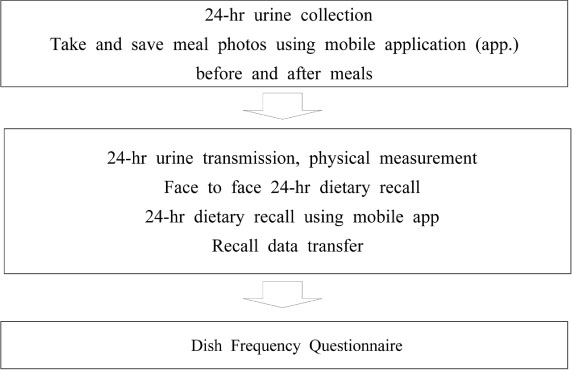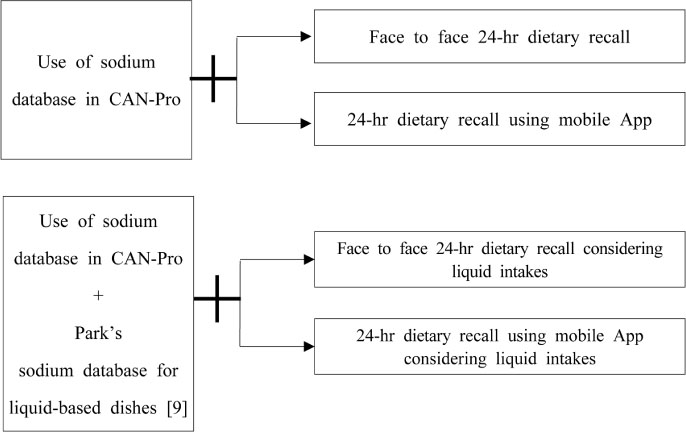Articles
- Page Path
- HOME > Korean J Community Nutr > Volume 25(4); 2020 > Article
- Research Article
- Validity of Estimating Sodium Intake using a Mobile Phone Application of 24-hour Dietary Recall with Meal Photos
- Seo-Yoon Kim, Sang-Jin Chung
-
Korean Journal of Community Nutrition 2020;25(4):317-328.
DOI: https://doi.org/10.5720/kjcn.2020.25.4.317
Published online: August 31, 2020

2Professor, Department of Foods & Nutrition, Kookmin University, Seoul, Korea

-
Corresponding author:
Sang-Jin Chung,
Email: schung@kookmin.ac.kr
- 946 Views
- 9 Download
- 3 Crossref
- 0 Scopus
Abstract
Objective
The objective of this study was to verify the validity of a mobile phone application (app) that applies a 24-hour dietary recall with meal photos, as a means of being a more accurate method of estimating dietary sodium intake.
Methods
Of the 203 subjects enrolled, 172 subjects (84 males and 88 females) were selected for the final analysis, excluding those with an intake less than 500 kcal and urine output less than 500 ml. Dietary sodium assessment methods used for comparing with the 24-hour urinary sodium excretion are as follows: 1) face-to-face 24-hour dietary recall, 2) 24-hour dietary recall using the mobile app, 3) face-to-face 24-hour dietary recall considering liquid intakes from soup, stew, water kimchi and noodle, etc (liquid-based dishes), 4) 24-hour dietary recall using the mobile app considering liquid intakes from liquid-based dishes, and 5) food frequency questionnaire. Repeated ANOVA with Bonferroni method was used for comparing the average sodium intake, and Pearson’s correlation was applied to correlate the methods used.
Results
In women, no significant difference was observed in the average sodium intake between all methods. Moreover, analysis in men and total adults revealed no significant difference between the 24-hour urinary sodium secretion, and 24-hour dietary recall using the app and 24-hour dietary recall using the app considering liquid intakes.
Sodium intake by food frequency questionnaire was significantly different when compared with the intake determined from 24-hour urinary sodium excretion. Sodium intake from all methods (except food frequency questionnaire) significantly correlated with values obtained from 24-hour urine sodium excretion.
Conclusions
Results of this study validated a mobile phone app using a 24-hour dietary recall with meal photos to better estimate dietary sodium intakes. It is believed that further studies in the future will enable the application as a tool to more accurately determine sodium intake.
Published online Aug 31, 2020.
https://doi.org/10.5720/kjcn.2020.25.4.317
Validity of Estimating Sodium Intake using a Mobile Phone Application of 24-hour Dietary Recall with Meal Photos
Abstract
Objectives
The objective of this study was to verify the validity of a mobile phone application (app) that applies a 24-hour dietary recall with meal photos, as a means of being a more accurate method of estimating dietary sodium intake.
Methods
Of the 203 subjects enrolled, 172 subjects (84 males and 88 females) were selected for the final analysis, excluding those with an intake less than 500 kcal and urine output less than 500 ml. Dietary sodium assessment methods used for comparing with the 24-hour urinary sodium excretion are as follows: 1) face-to-face 24-hour dietary recall, 2) 24-hour dietary recall using the mobile app, 3) face-to-face 24-hour dietary recall considering liquid intakes from soup, stew, water kimchi and noodle, etc (liquid-based dishes), 4) 24-hour dietary recall using the mobile app considering liquid intakes from liquid-based dishes, and 5) food frequency questionnaire. Repeated ANOVA with Bonferroni method was used for comparing the average sodium intake, and Pearson's correlation was applied to correlate the methods used.
Results
In women, no significant difference was observed in the average sodium intake between all methods. Moreover, analysis in men and total adults revealed no significant difference between the 24-hour urinary sodium secretion, and 24-hour dietary recall using the app and 24-hour dietary recall using the app considering liquid intakes. Sodium intake by food frequency questionnaire was significantly different when compared with the intake determined from 24-hour urinary sodium excretion. Sodium intake from all methods (except food frequency questionnaire) significantly correlated with values obtained from 24-hour urine sodium excretion.
Conclusions
Results of this study validated a mobile phone app using a 24-hour dietary recall with meal photos to better estimate dietary sodium intakes. It is believed that further studies in the future will enable the application as a tool to more accurately determine sodium intake.
Fig. 1
Diagram of the study procedure sequence.
Fig. 2
Diagram of estimation of sodium intakes using 24-hr dietary recall methods
Table 1
Subject's characteristics
Table 2
Comparison of daily sodium intakes estimated by different methods
Table 3
Correlations among estimated sodium intakes of total adults by different methods
Table 4
Correlations among estimated sodium intakes of men by different methods
Table 5
Correlations among estimated sodium intakes of women by different methods
Acknowledgments
This research was supported by Basic Science Research Program through the National Research Foundation of Korea (NRF) funded by the Ministry of Education (NRF-2013R1A1A2059985).
References
-
Wardener de HE, MacGregor GA. Harmful effects of dietary salt in addition to hypertension. J Human Hypertens 2002;16(4):213–223.
-
-
Kurosawa M, Kikuchi S, Xu J, Inaba Y. Highly salted food and mountain herbs elevate the risk for stomach cancer death in a rural area of Japan. J Gastro Hepa 2006;21(11):1681–1686.
-
-
Blaustein MP, Hamlyn JM. Role of natriuretic factor in essential hypertension: an hypothesis. Ann Intern Med 1983;98(5pt2):785–792.
-
-
Yon M, Lee J, Koh E, Nam E, Shin H, Kang BW. Major sources of sodium intake of the Korean population at prepared dish level: based on the KNHANES 2008 & 2009. Korean J Community Nutr 2011;16(4):473–487.
-
-
Ministry of Health and Welfare (KR), Korea Center for Disease Control and Prevention. Korea Health Statistics 2016: Korea National Health and Nutrition Examination Survey (KNHANES VII-1). Cheongju: Korea Center for Disease Control and Prevention; 2017.
-
-
Kim HH, Lee YK. Analysis of presumed sodium intake of office workers using 24-hour urine analysis and correlation matrix between variables. Korean J Nutr 2013;46(1):26–33.
-
-
Park YH. In: Analysis of sodium and potassium contents in Korean soup and stew (liquid-based dishes) from home meal, school meal and eat-out. [Masters dissertation]. Kookmin University; 2016.
-
-
Loria CM, Obarzanek E, Ernst ND. Choose and prepare foods with less salt: dietary advice for all Americans. J Nutr 2001;131(2):536–551.
-
-
Shin EK, Lee HJ, Lee JJ, Ann MY, Son SK, Lee YK. Estimation of sodium intake of adult female by 24-hour urine analysis, dietary records and Dish Frequency Questionnaire (DFQ 55). Korean J Nutr 2010;43(1):79–85.
-
-
Kim HH, Shin EK, Lee HJ, Lee NH, Chun BY, Ahn MY. Analysis by delphi survey of a performance evaluation index for a salt reduction project. Korean J Nutr 2009;42(5):486–495.
-
-
Son SM, Huh KY. Salt intake and nutritional problems in Korean. Korean J Community Nutr 2002;7(3):381–390.
-
-
Son SM, Park YS, Lim WJ, Kim SB, Jeong YS. Development and evaluation of validity of short dish frequency questionnaire (DFQ) for estimation of habitual sodium intake for Korean adults. Korean J Community Nutr 2007;12(6):838–853.
-
-
Cade J, Thompson R, Burley V, Warm D. Development, validation and utilisation of food-frequency questionnaires - a review. Pubilc Health Nutr 2002;5(4):567–587.
-
-
Dwyer JT, Krall EA, Coleman KA. The problem of memory in nutritional epidemiological research. J Am Diet Assoc 1987;87(11):1509–1512.
-
-
Willet W. In: Nutritional epidemiology. 3rd ed. New York: Oxford University Press; 2012. pp. 51.
-
-
Krall EA, Dwyer JT, Coleman KA. Factors influencing accuracy of dietary recall. Nutr Res 1998;8(7):829–841.
-
-
Kim SY, Chung SJ. Development and User Satisfaction of a Mobile Phone Application for Image-based Dietary Assessment. Korean J Community Nutr 2017;22(6):485–494.
-
-
Yoon YO, Kim ES, Ro HK. Potassium intakes of some industrial workers. Korean J Nutr 1991;24(4):344–349.
-
-
Dawn K. Effect of potassium on blood pressure in salt sensitive and salt resistant black adolescents. Hypertension 1999;34(2):181–186.
-
-
Ban DE. In: Survey in sodium intakes and dietary behaviors among elementary school student in Seoul [Masters dissertation]. Kookmin University; 2014.
-
-
Lazarte CE, Encinas ME, Alegre C, Granfeldt Y. Validation of digital photographs, as a tool in 24-h recall, for the improvement of dietary assessment among rural populations in developing countries. Nutr J 2012;11(1):1–14.
-
-
Seo JS, Lee JH, Yun JD, Cho SH, Choi YS. In: Nutritional assessment. 3rd ed. Seoul: Powerbook; 2008. pp. 112.
-
-
Lee HJ, Lee JS. Supporting sustainable food logging by adjusting the degree of data input structure; Proceeding of HCI KOREA; 2016 Jan 27; Kangwon. pp. 677-679.
-
-
Kim OS. BMI, body attitude and dieting among college women. J Korean Acad Adult Nurs 2002;14(2):256–264.
-
-
Ingwersen LA, Raper NR, Anand J, Moshfegh AJ, Food Surveys. Validation study shows importance of probing for forgotten foods during a dietary recall. J Am Diet Assoc 2004;104:13
-
-
Son SM, Huh KY. Salt intake and nutritional problems in Korean. Korean J Community Nutr 2002;7(3):381–390.
-
-
Kirkendall AM, Connor WE, Abboud F. The effect of dietary sodium chloride on blood pressure, body fluids, electrolytes, renal function and serum lipids of normotensive man. J Lab Clin Med 1976;87(3):411–434.
-
-
Kim YS, Paik HY. Measurement of Na intake in Korean adult females. Korean J Nutr 1987;20(5):341–349.
-
-
Liu K, Stamler J. Assessment of sodium intake in epidemiological studies on blood pressure. Ann of Clin Res 1983;16(43):49–54.
-

 KSCN
KSCN








 Cite
Cite


